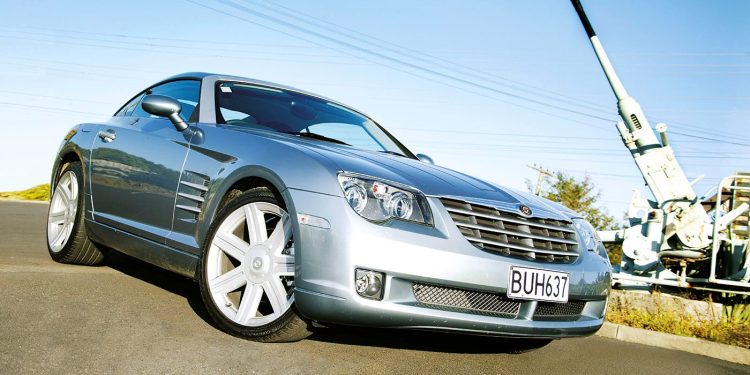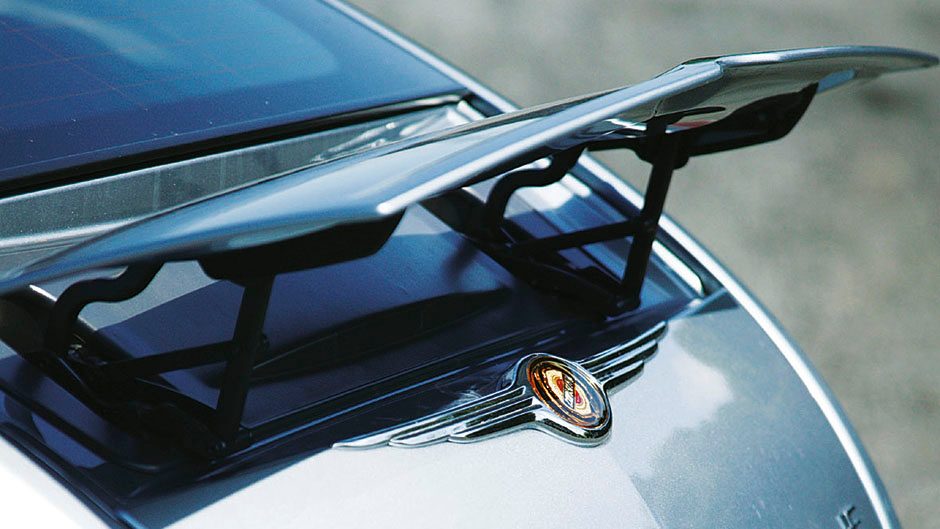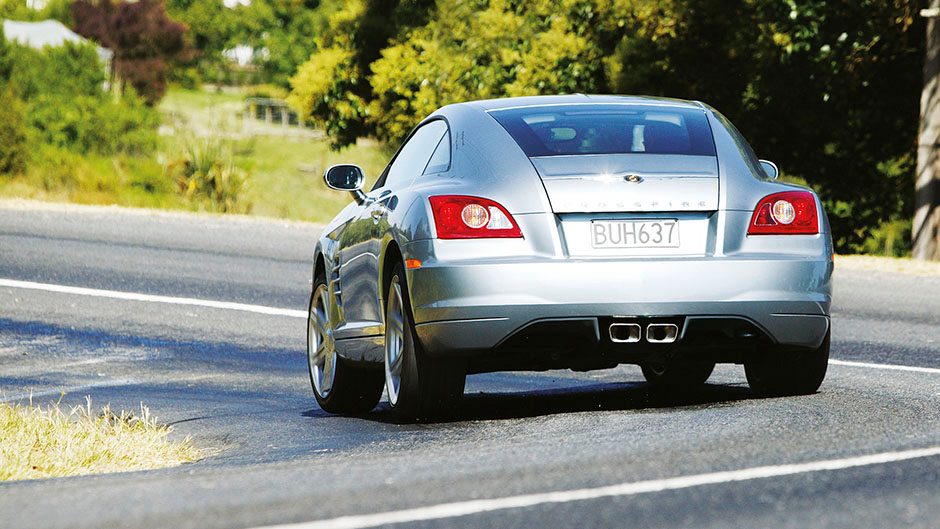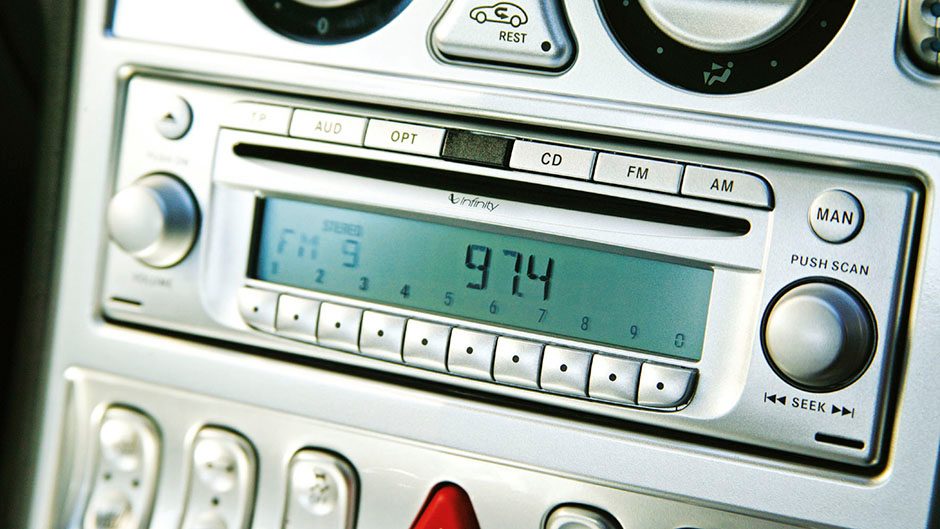2004 Chrysler Crossfire review
Words Peter Louisson | Photos Tom Gasnier
Here, at last, is a Chrysler sports-coupé in the mould of the awesome e49 Charger R/T. Crossfire might look diminutive beside an e49, but a Mercedes-sourced chassis and powertrain ensure that it doesn’t lack for firepower.
The New Zealand division of DaimlerChrysler must be feeling pretty chipper at present, despite the offshore welter of bad news surrounding the ‘merger of equals’, profit hiccups following Mitsubishi problems, and a lawsuit pending. Worse, there has not been a lot of new product from Chrysler lately, more a case of reinventing old wheels with new engines or modified bodies.
So the introduction of an image-enhancing sports coupé, the Crossfire, was enough to get the local DaimlerChrysler crowd jumping. Crossfire was an opportunity for the DC team to showcase a smart new contender in a segment of the market it has never contested. Moreover, it’s the first pukka sportscar from Chrysler in 75 years, if you discount the classic Charger R/T as a Bathurst special of regional significance only.
Representatives of the media were invited on a launch drive to Pauanui – and then a launch trip across to nearby Slipper Island. For once, the fickle weather cooperated and on a brilliant autumnal day we had a chance to do the sorts of lifestyle things DC staff reckon potential Crossfire purchasers will have a crack at.
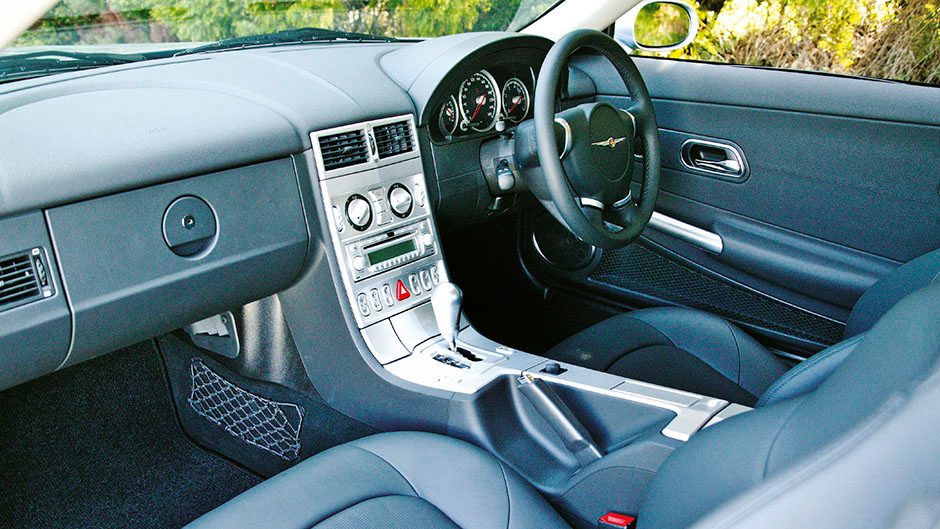
First up, a fang in what has to be the best-looking Chrysler to head to these shores since the all-conquering Charger. A good two-hour shakedown drive it was too, despite the frustration of the Kopu to Hikuai sector. You invariably get a few kays down the road only to encounter a camper van following a logging truck that’s trying to pass a clapped-out import SUV. Fortunately, the Clevedon to Kaiaua section was quieter, and allowed us to explore the dynamic envelope of the Mercedes SLK-derived two-seater. The Kopu section offered only a chance to swap tall stories with my travelling companion. Who’s in very close proximity. Which is the point of this car.
Viewed from the mainland, you might get the idea there’s nothing much on Slipper Island. Actually, there’s a lodge, some chalets and lots to do. If hiking’s your thing, this island offers cliff-top scenery, hidden bays, an extinct volcano and a functioning lighthouse to check out, along with stunning views. Highly recommended, not just for Crossfiring couples! Chrysler has its sights set on expansion here, and Crossfire should help to achieve this, though likely in only a small way. Think of this vehicle more as an image massager; it’s there to get a styling message across, fire the imagination.
The union with Daimler-Benz has opened up intriguing possibilities and opportunities for Chrysler with platform-sharing and technology-swapping. A cynic might suggest that Chrysler was the major beneficiary of the merger of unequals – driving Crossfire you’re left in no doubt you’ve essentially got a half-price SLK 320 in Oscar-night livery. Which probably shouldn’t upset Mercedes unduly as a new SLK is due here by the end of the year (see page 66). On the other hand, one could view this situation as recycling ‘old’ mechanicals at fire-sale prices. The real point locally is that Chrysler is venturing back into the passenger-car arena, albeit in the niche and fiercely competitive sports-car segment. It is promising to deliver a Falcon/Commodore-sized passenger car in 2005, the 300C sedan, also based on M-B mechanicals.
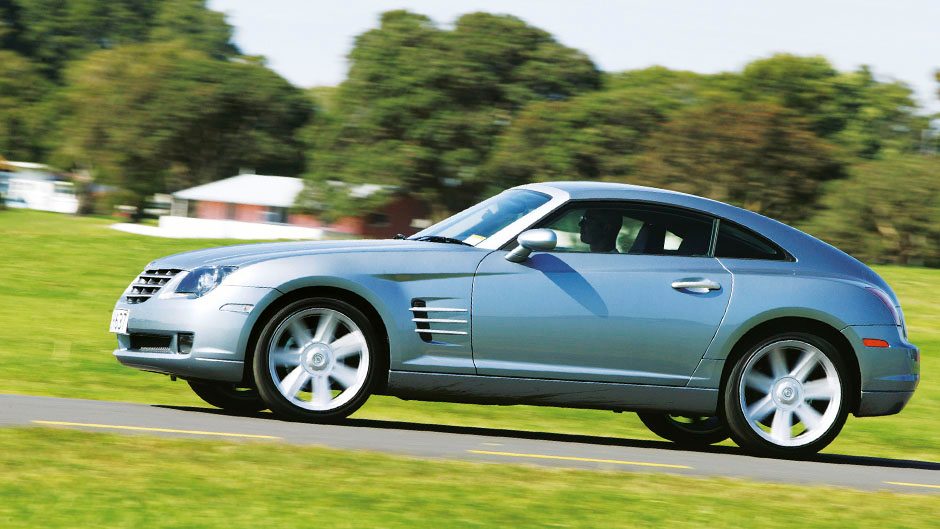
A supercharged convertible version of the Crossfire will be added towards the end of this year, and a convertible Cruiser is in the wings, so it’s all go on the product front. What’s also clear is that the technology- and platform-sharing is driving new Chrysler product. Development takes mere months rather than years. For example, it took just 10 months to bring to fruition the ME Four-Twelve supercar concept that uses a Mercedes quad-turbo V12. Crossfire is instantly notable for its slick build. Its paintwork (five options) is rich, deep, lustrous and slick, panel gaps are convincingly even, and there’s a taut, solid feel to door and hatch closure that bests, or at least equals, the similarly priced competition. That the car is screwed together by noted German coach builder, Karmann, explains why this new breed of Chrysler, the first real pearl from the DC union, feels so reassuringly solid. To be fair, the engineering is not all Mercedes, only 39 per cent of it is. But plenty of those bits are key to the Crossfire’s character, like the aluminium 3.2 litre 160kW V6 engine, and the SLK platform and suspension.
As an aside, the Crossfire nametag has nothing to do with the bellicose blunderings of the Bush administration’s foreign policy initiatives, and everything to do with a rising contour line that starts behind the front wheel arch as an indent and crosses over the flanks of the car as a convex crease. It also serves to accentuate the rising wedge line. Not that it aids airflow especially; a Cd of 0.37 is hardly cutting edge, and the top speed of the car is aerodynamically dictated at 242km/h.
The Crossfire concept first aired at the 2001 Detroit Show, and with the endorsement of the show-goers, made it to production almost unchanged within 18 months. Unique design elements that give the car its distinctive appearance include the ribbed bonnet, resembling an overturned boat hull, and the fastback ‘boat-tail’ rear end. These features and the strong haunches give the car a boatload of presence. The car resembles the SLK in absolutely no way externally, save perhaps its abbreviated wheebase and 4.0m length. But in the compact cabin, the opposite is true where much about the instruments and controls is familiar, or is lifted wholesale from SLK with minor cosmetic embellishment.
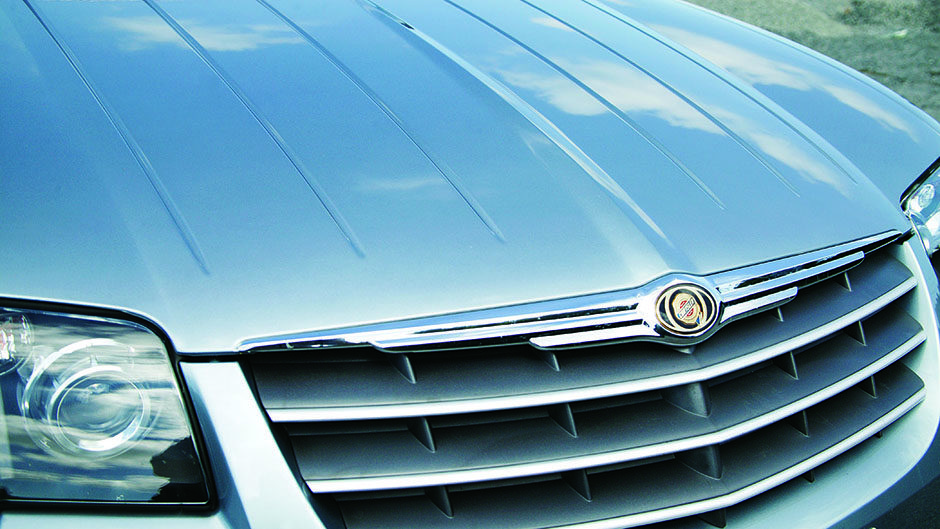
The Crossfire’s design has a central spine theme that continues on both sides of the roofline, with a bisecting line that externally resembles that of the current Primera. One special feature that has claimed benefits, and will appeal to the kids and egotists in the family, is the retractable rear spoiler. Hiding in a hatch recess, it pops up at speeds in excess of 90km/h and ostensibly improves stability at high speed. It retracts again at 60km/h, but there’s a manual override button for the ego-challenged. The spoiler does have a real practical benefit: using the manual override button you can handily set the spoiler position to horizontal – perfect for resting beer cans at the beach or rugby. Low alcohol, natch.
Actually, there’s serious intent to the aggressive appearance. It’s the best-looking Chrysler yet, even with its fake warm-air extractors behind the front wheel arches. A point of difference from its competitors are the asymmetrical front and rear wheel sizes, with 18-inch rims up front and 19-inch alloys rear, packing 255/30 ContiSportContact2 rubber. While you’re round the back end, check out the centrally mounted twin exhausts. It’s a good look, popularised by Pagani Zonda, but beware poking around in the luggage bay when the engine’s running. That smell is your leg hair or nylons burning. The hatch opening is tight, but with a bit of careful juggling you can fit a couple of sets of golf clubs in there.
There’s more to the curvy bodyshell than meets the eye. Chrysler claims Porsche-matching torsional rigidity, with the objective of offering responsive handling and a supple ride. To this end, the curved rear pillars, small glass-to-steel ratio, and the immense bulkhead dividing the passenger area from the luggage bay are key to achieving desired structural stiffness.
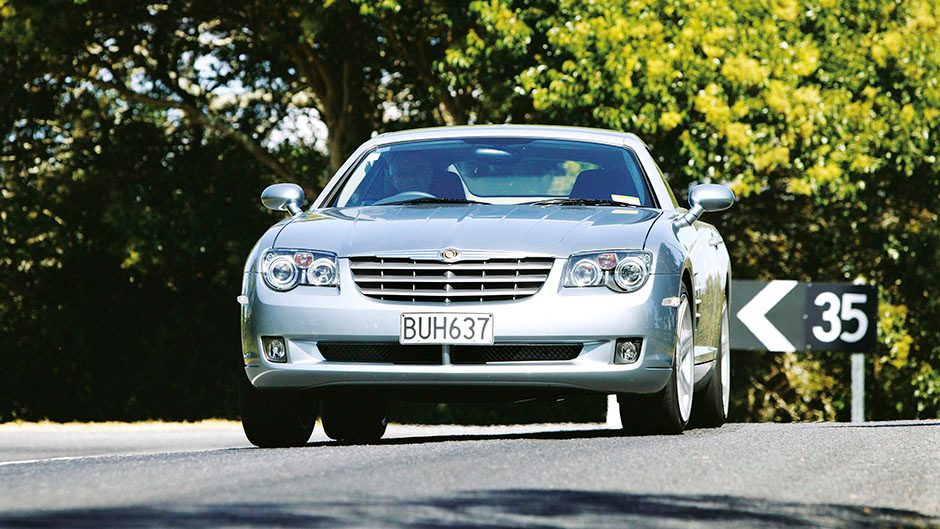
Chrysler engineers have done little to the powerplant, and power output is no different from that of the SLK engine. Ancillaries like intake and exhaust systems have been tweaked to give Crossfire a distinctive and exciting exhaust reverb. The single-cam 18-valve V6 is rated at 160kW, while torque is up slightly from 300 to 310Nm, produced at a usefully low 3000rpm. The peak of the torque curve is essentially flat between 3000 and 4500rpm, and that translates to the driving experience as well. Using the rev range between 3000 and 5500rpm, you can keep pace with almost any low flier. The limiter cuts in at 6000rpm, and the last few are a last gasp anyway. Purchasers have the choice, at no cost difference, between an adaptive five-speed automatic transmission with ‘AutoStick’ manual gear selection and a six-speed short-throw manual gearbox.
Our automatic evaluation Crossfire had only 650km on the clock when we performance tested it with the VBOX. Chrysler claims 0-100km/h is possible in 6.9 seconds against the manual version’s 6.5s. Our automatic car managed a creditable 7.17s. Not bad considering it needs two gearshifts to reach the open-road legal limit. A best 100-0km/h braking distance was achieved in 34.90m, perhaps not quite as good as expected, given the reasonable overall weight (1404kg fully fuelled) and big footprint. But there’s good power and feel at the brake pedal, and it’s a reassuring stopper on the prowl.
In terms of the competition, Monaro is the nearest on price, costing $2K more, and the 350Z coupé closest for concept, but it’s $7K-10K less. The Zed convertible is pitched at the same price as the Crossfire. Both the 350Z and Monaro vehicles have a considerable power advantage, though the power-to-weight figures aren’t too disparate, with the Monaro on 6.78kg/kW, the 350Z at 7.33, and the Crossfire on 8.78. Mazda’s RX-8, with a power-to-weight figure of 7.7kg/kW and costing $62,000 in either manual or automatic mode, is the other prime contender.
Survival is the name of the game in this sector, and Crossfire will have its work cut out, to be sure. In two months of marketing in Oz, 50 vehicles have been retailed, and while it’s early days yet, the annual figure of 80 units here seems ambitious. Crossfire may not be the quickest or the most adept in any single area, and it certainly isn’t commodious in the way the Monaro is, but it has an appealing, muscular, sporty appearance, a useful engineering pedigree, and a turn of speed and degree of road worthiness that may appeal to those who aspire to an SLK320, but baulk at the $130K cost. The fact that the Crossfire, with similar mechanicals, is available at well under two-thirds this figure should pique plenty of interest. Particularly in view of the fact that it’s the best-built Chrysler we’ve ever stepped into.
| Model | 2004 Chrysler Crossfire | Price | $74,990 |
| Engine | 3199cc, V6, EFI, 160kW/310Nm | Drivetrain | 5-speed auto, rear-wheel drive |
| Fuel Use | XL/100km | C02 Output | Xg/km |
| 0-100km/h | 7.17sec | Weight | 1404kg |


